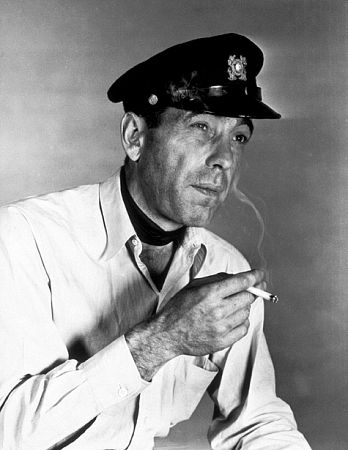|
Humphrey Bogart
Scroll down for movie list.
Biography from Leonard Maltin's Movie Encyclopedia:
One of the screen's most legendary figures was a pop-culture icon to generations of movie watchers unborn when he enjoyed his initial successes. Bogart was also an extremely unlikely bet for stardom: His slight stature, weatherbeaten features, scarred lip, and withering snarl hardly qualified him in Hollywood's glamour-obsessed Golden Age. Fortunately for this talented tough guy, he was in the right place (Warner Bros.) at the right time (the onset of World War 2) to win audience approval in the rugged thrillers and action films in which that studio specialized.
Bogart, the son of a distinguished surgeon, actually studied medicine himself for a time before enlisting in the Navy during World War 1. Caught in a blast aboard ship, he sustained facial wounds that scarred and partially paralyzed his upper lip, accounting for one of his distinctive screen trademarks. A talented (and, according to silent-screen star Louise Brooks, sensitive) stage actor during the 1920s, Bogart made his screen debut in a 1930 short subject, Broadway's Like That and alternated stints in theater and film for the next few years. His career ratcheted upward when he played vicious killer Duke Mantee in "The Petrified Forest" on Broadway; costar Leslie Howard insisted he recreate the role in the 1936 film adaptation, which won him a Warners contract.
Although Bogart scored in Forest and, on loan to Goldwyn, in Dead End (1937, again playing a killer), his home studio mired him in B pictures (1936's Isle of Fury for example) and secondary roles in bigger-budgeted fare (supporting Bette Davis in 1937's Marked Woman and 1939's Dark Victory He was solid playing gangsters in 1938's Angels with Dirty Faces and 1939's The Roaring Twenties (both opposite Cagney), but was ludicrous as a zombie in 1939's The Return of Dr. X and a Mexican bandit in the 1940 Errol Flynn Western Virginia City
Bogart owes his stardom to George Raft, who turned down the two 1941 roles that boosted him to the top: "Mad Dog" Earle in High Sierra and Sam Spade in The Maltese Falcon. As his box-office standing improved, Warners designed vehicles that would enable him to retain his toughguy persona while playing sympathetic characters. Beginning with his "Rick" in Casablanca (1942), the single role for which he is best remembered (and which earned him his first Oscar nomination), Bogart etched memorable portraits as another Rick-type in To Have and Have Not (1944, during the production of which he met and married Lauren Bacall, his fourth and final wife), private eye Philip Marlowe in The Big Sleep (1946), a reformed crook in Key Largo (1948), the greed-crazed Fred C. Dobbs in The Treasure of the Sierra Madre (also 1948), a Hollywood burnout in In a Lonely Place (1950), the unstable Captain Queeg in The Caine Mutiny (1954, Oscar-nominated), an escaped killer in The Desperate Hours (1955), and a weary sportswriter in The Harder They Fall (1956, his last film).
While never noted as a comedian, Bogart was supremely funny in All Through the Night (1942), Sabrina (1954), and We're No Angels (1955), as well as The African Queen (1951, opposite Katharine Hepburn), in his Oscar-winning performance as boozy riverboat skipper Charlie Allnut. A lifelong smoker, he succumbed to throat cancer in 1957. Though well respected in his lifetime, Bogart didn't attain cult status until his films were rediscovered by younger viewers in the late 1960s: His blunt, no-nonsense, cynical and world-weary manner translated into a pop-culture existentialism that spoke volumes to the alienated youth of that turbulent era, and though the antiestablishment fervor has cooled, he remains arguably the most popular male star of Hollywood's Golden Age. |  |










